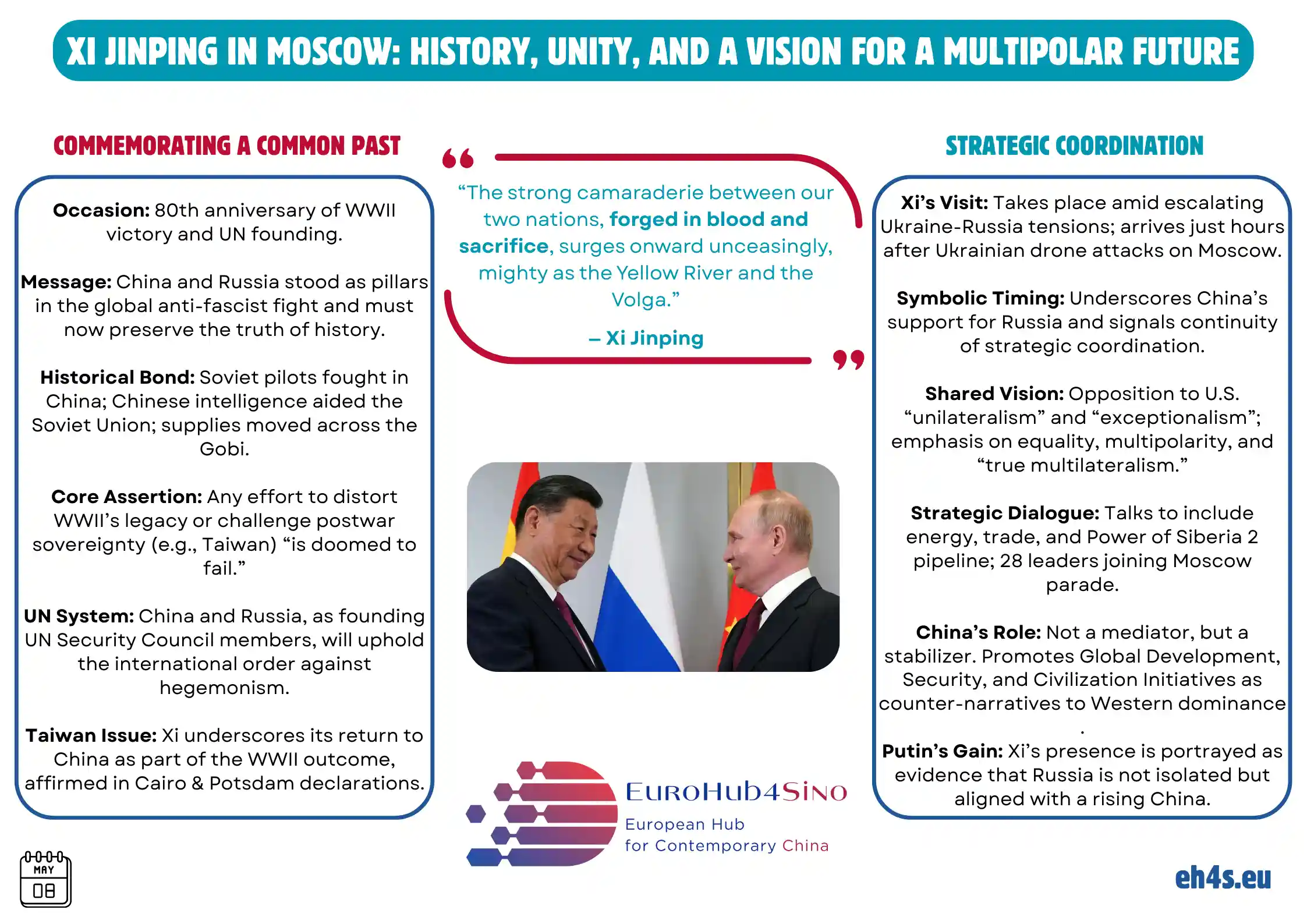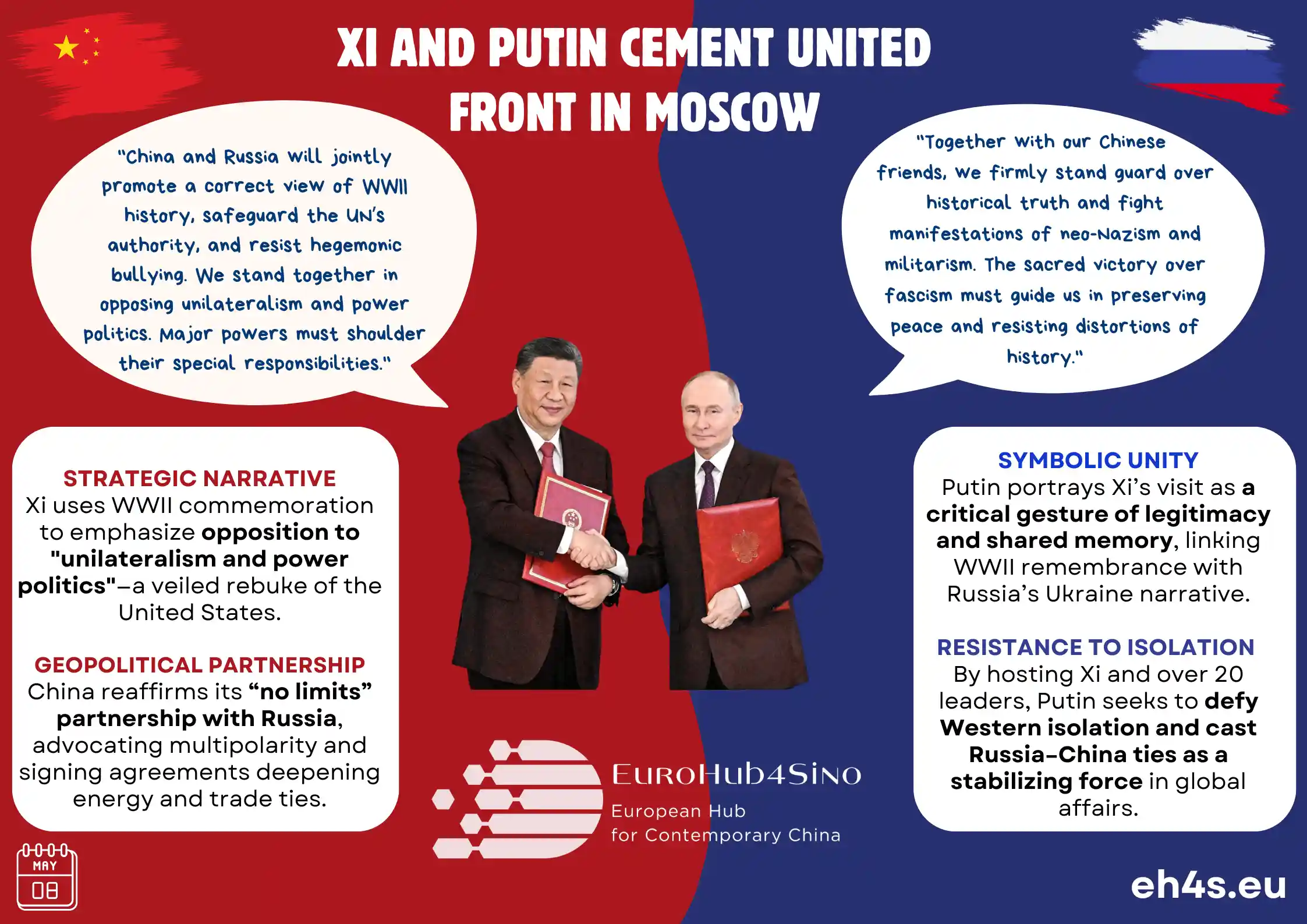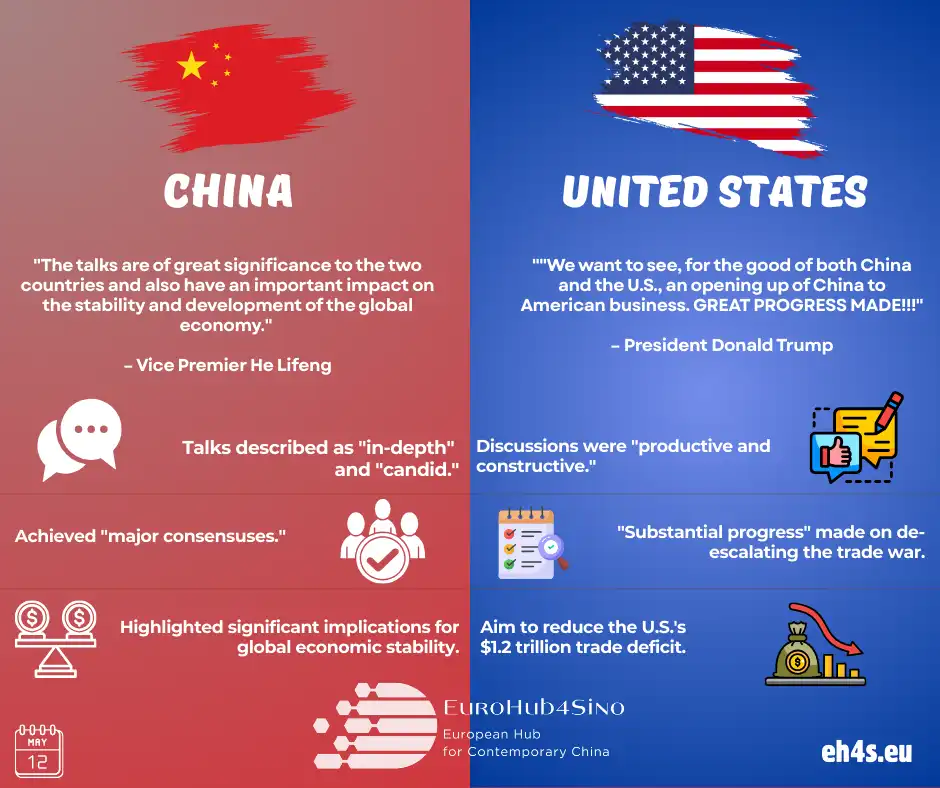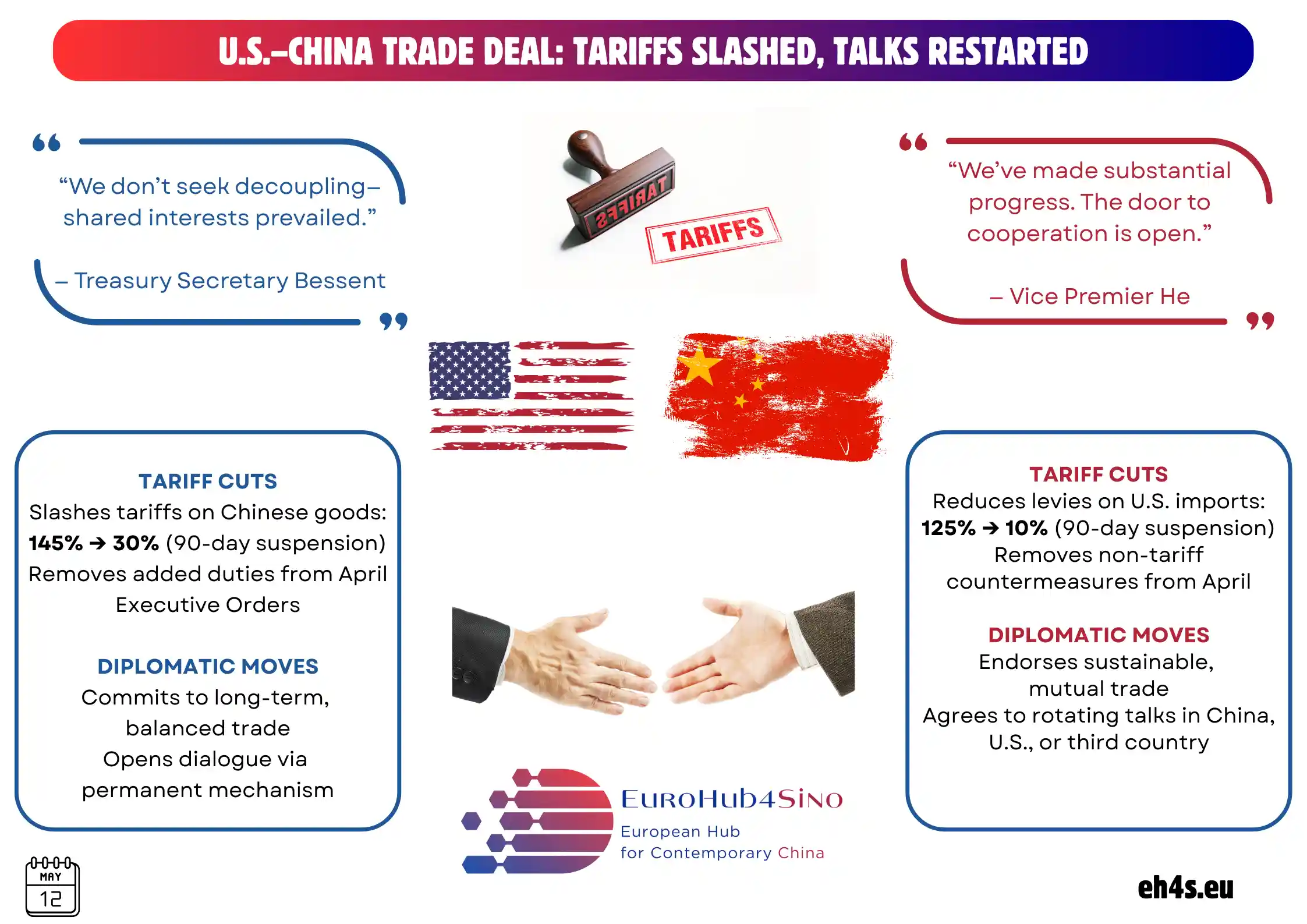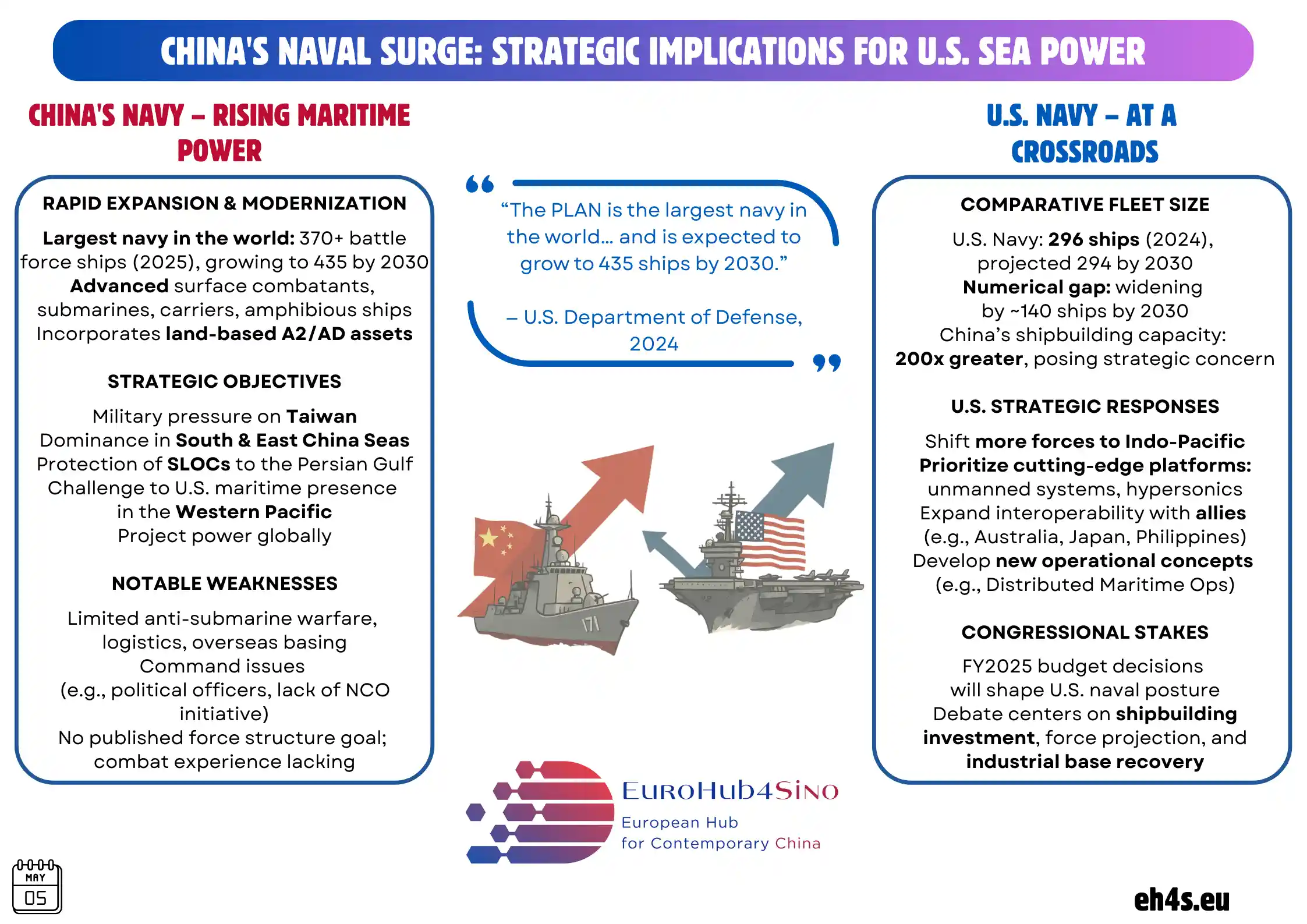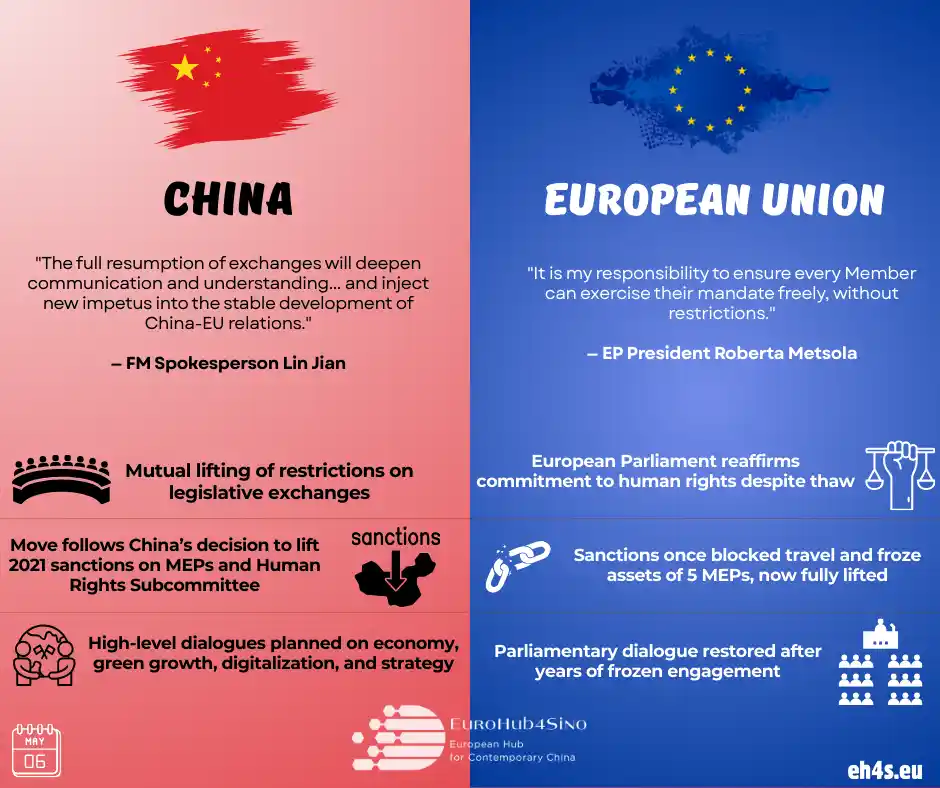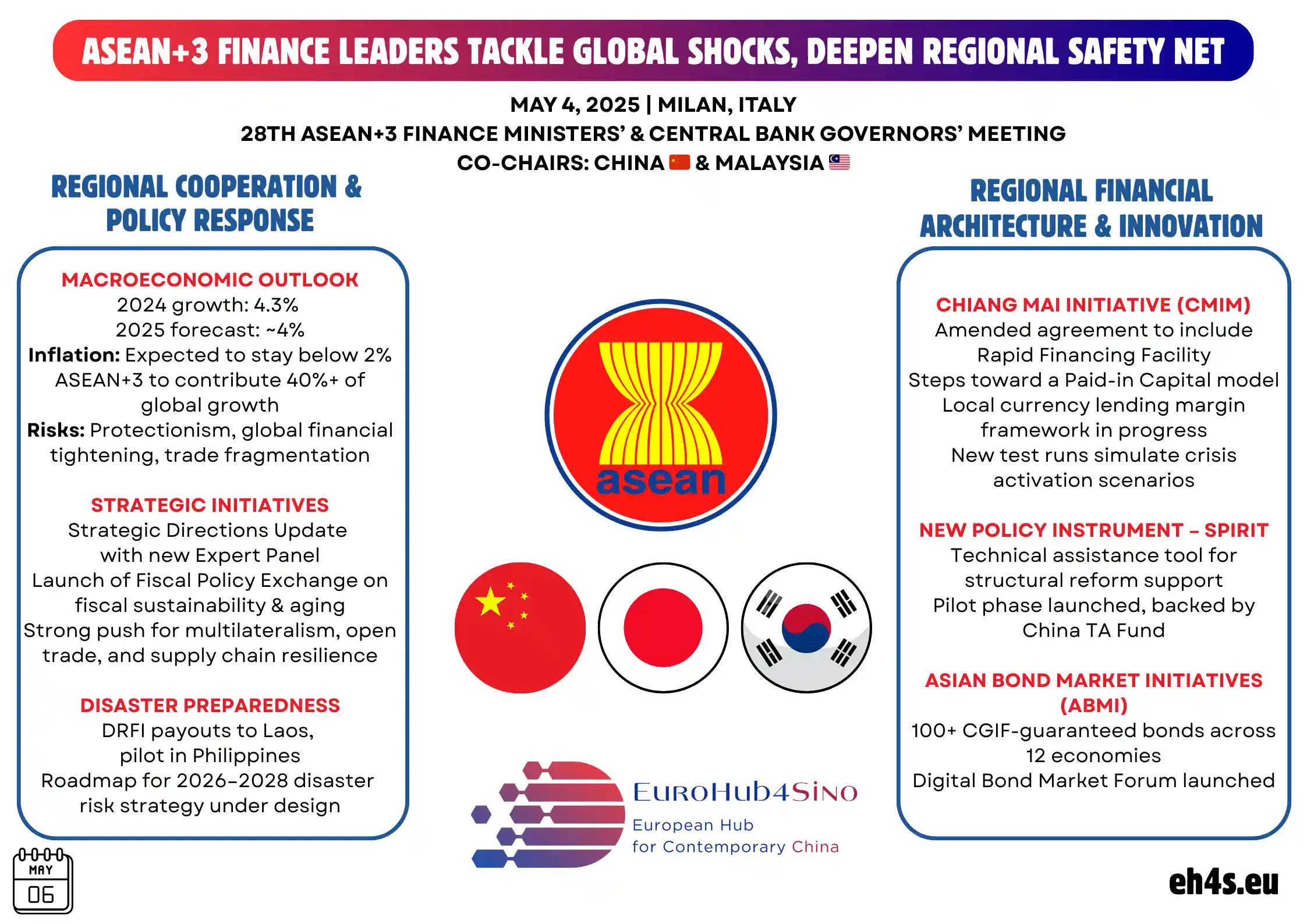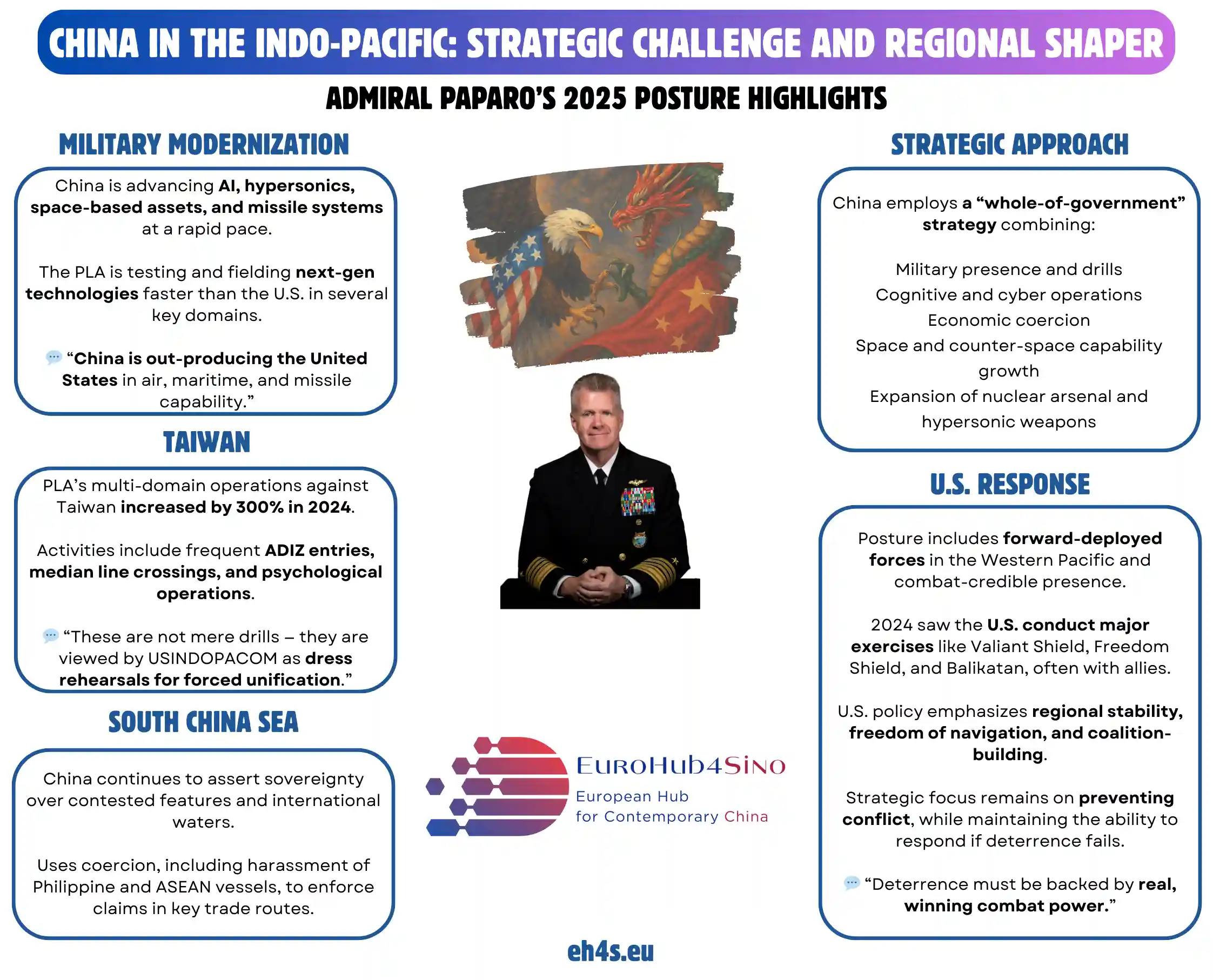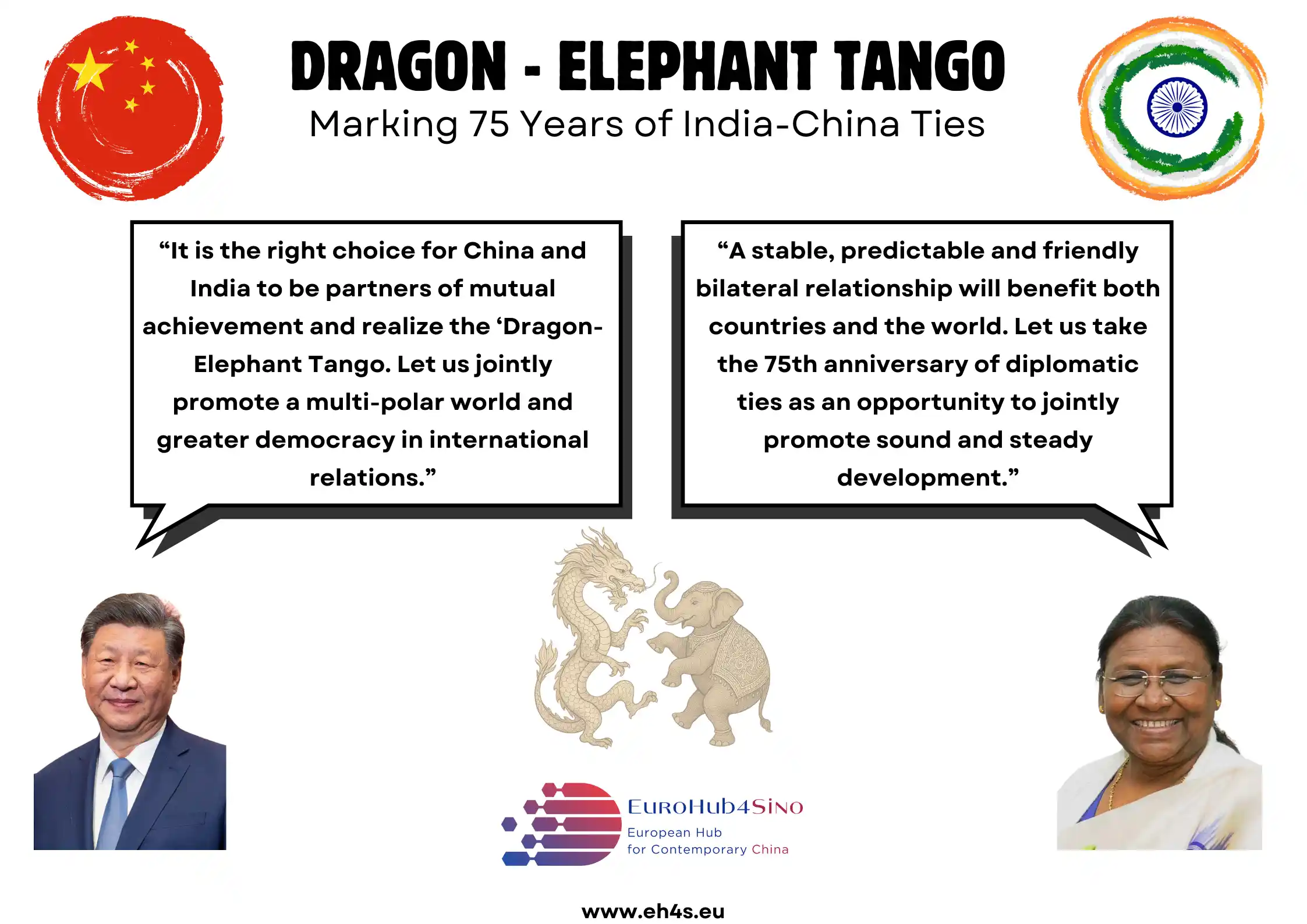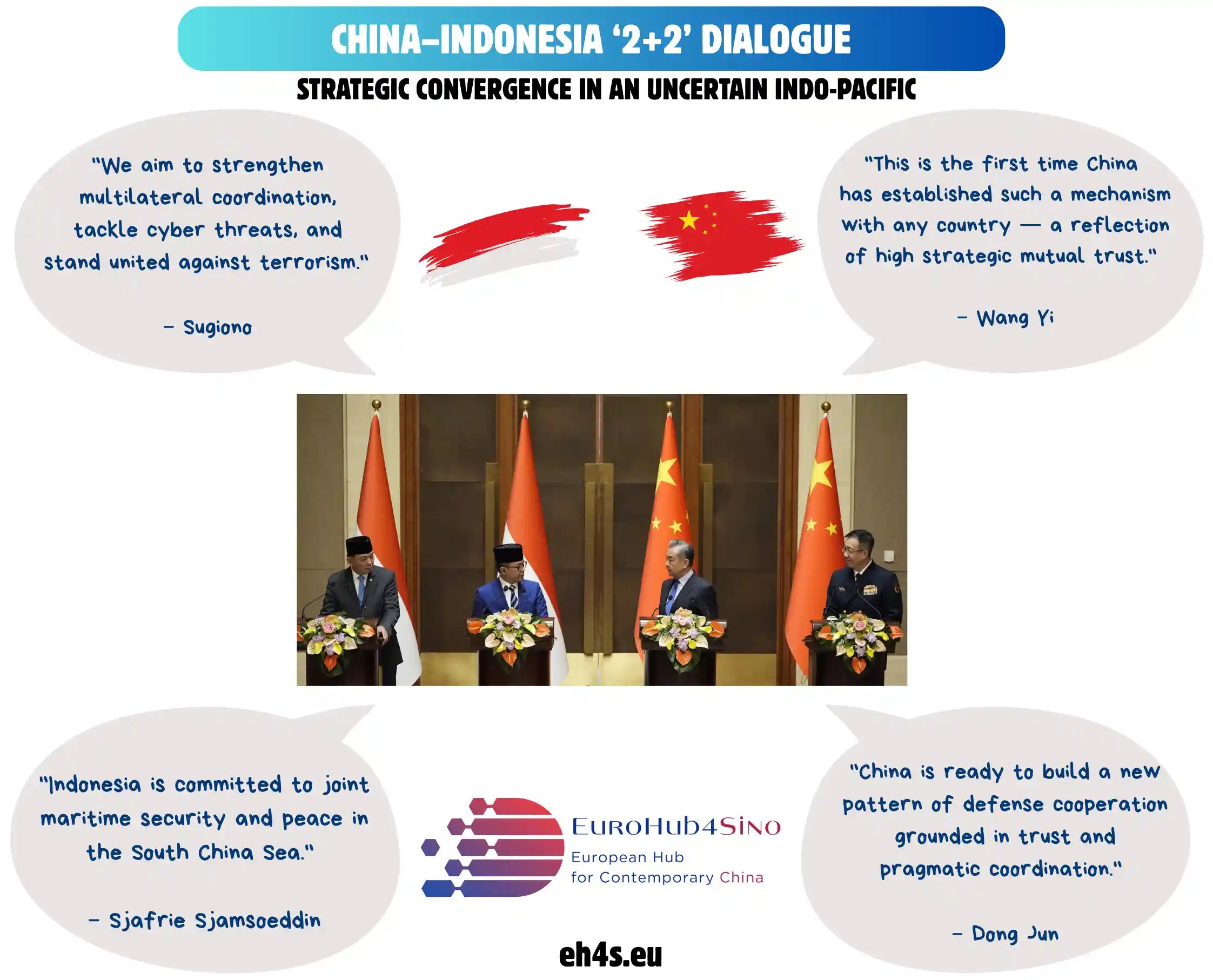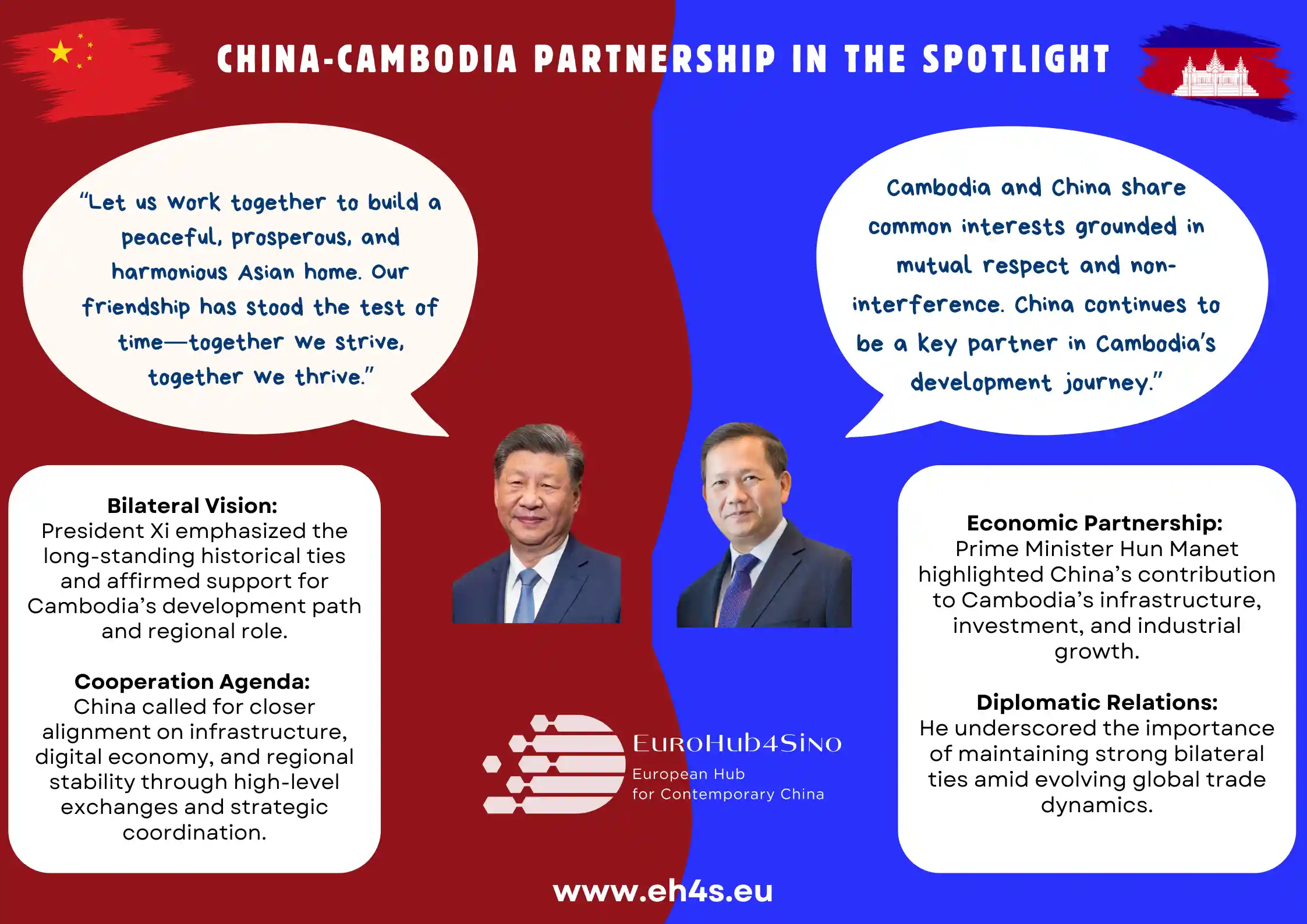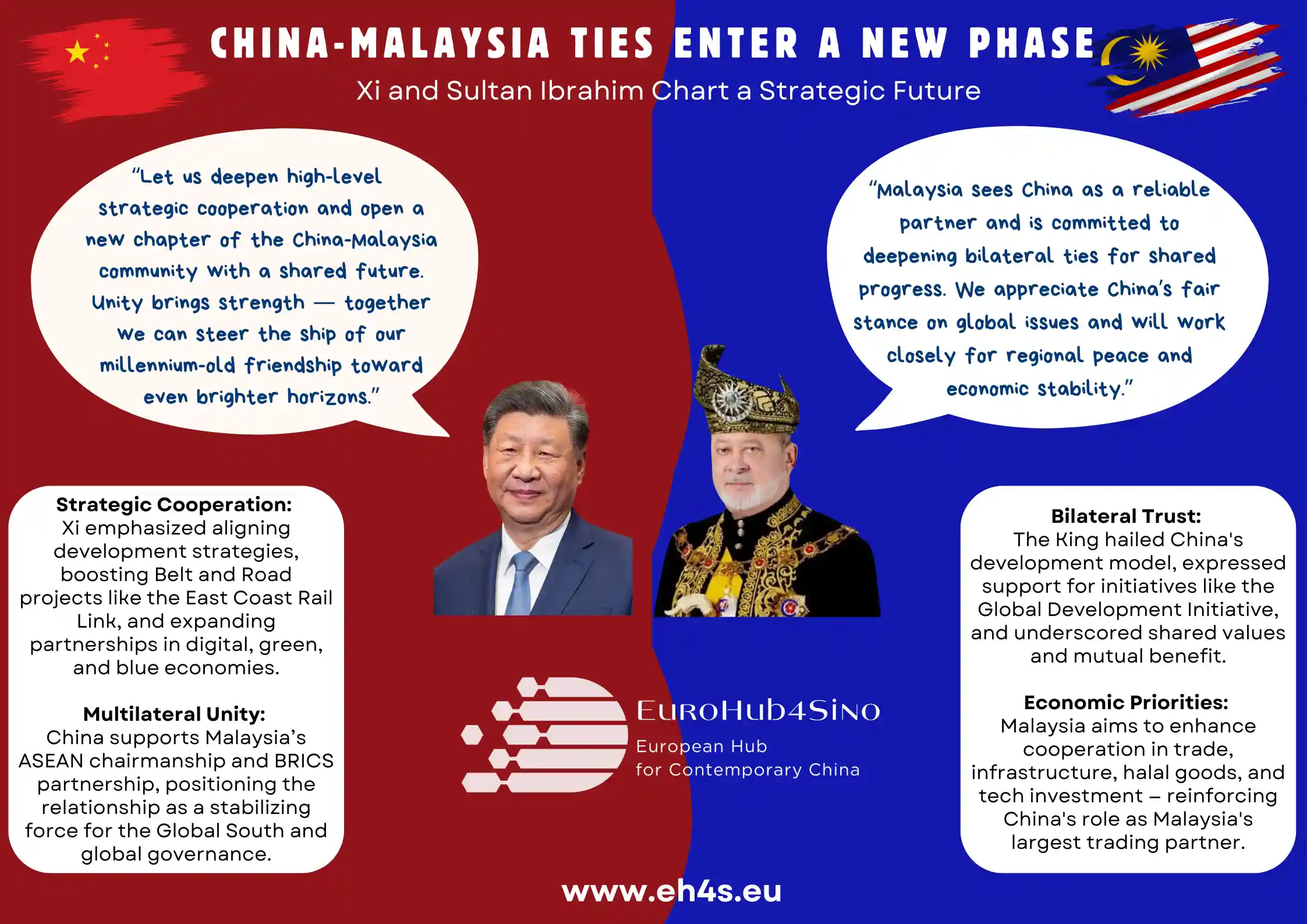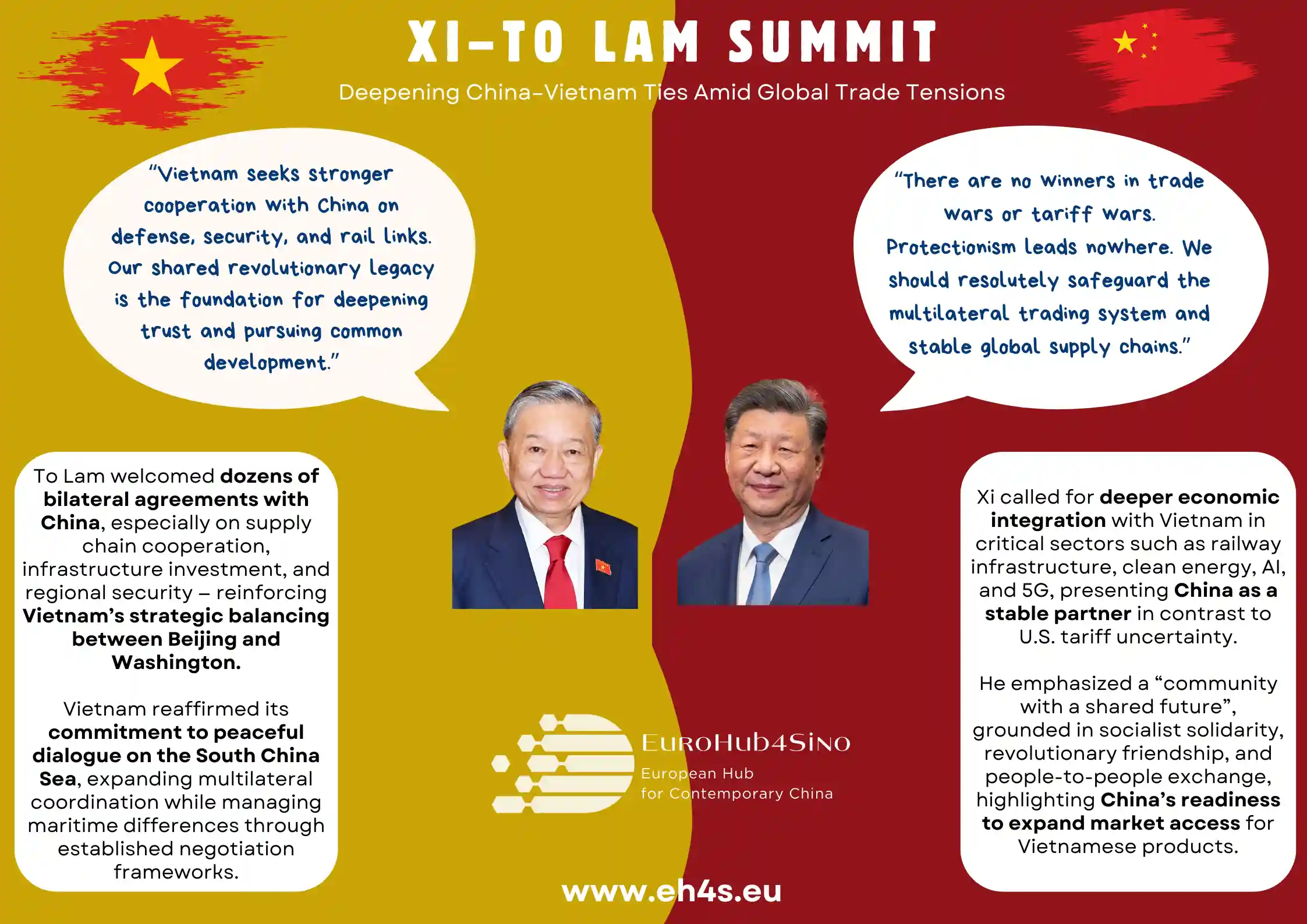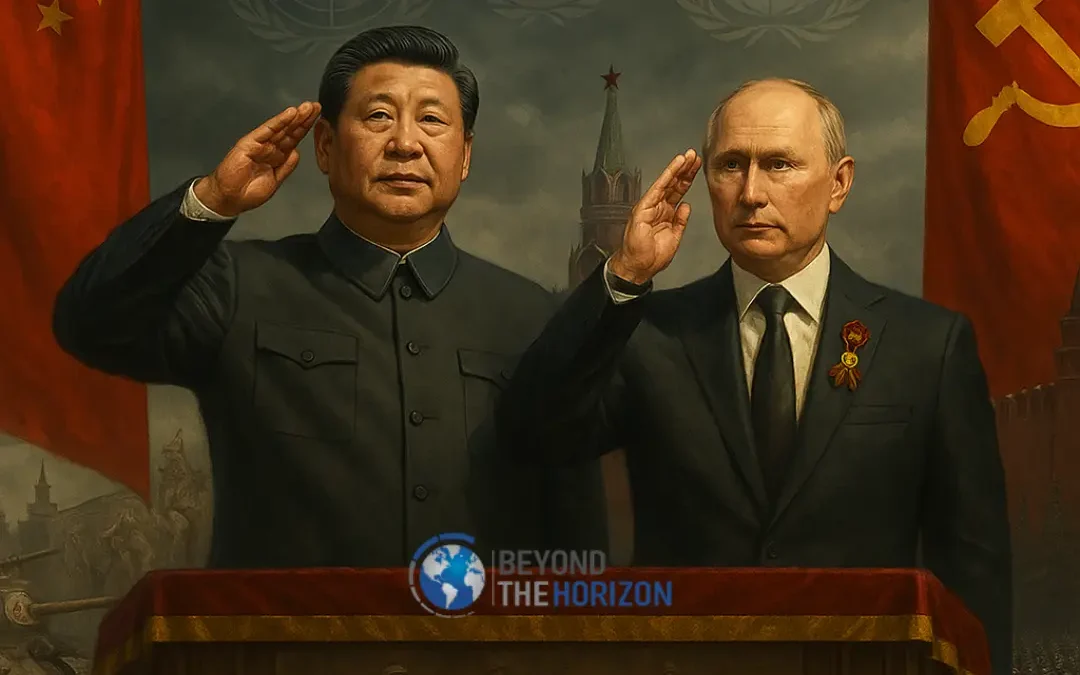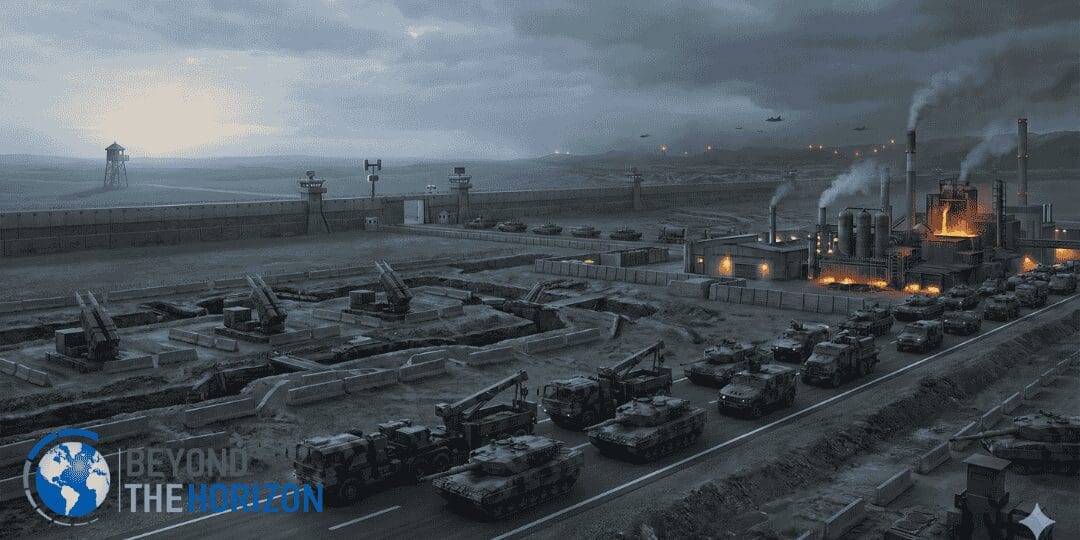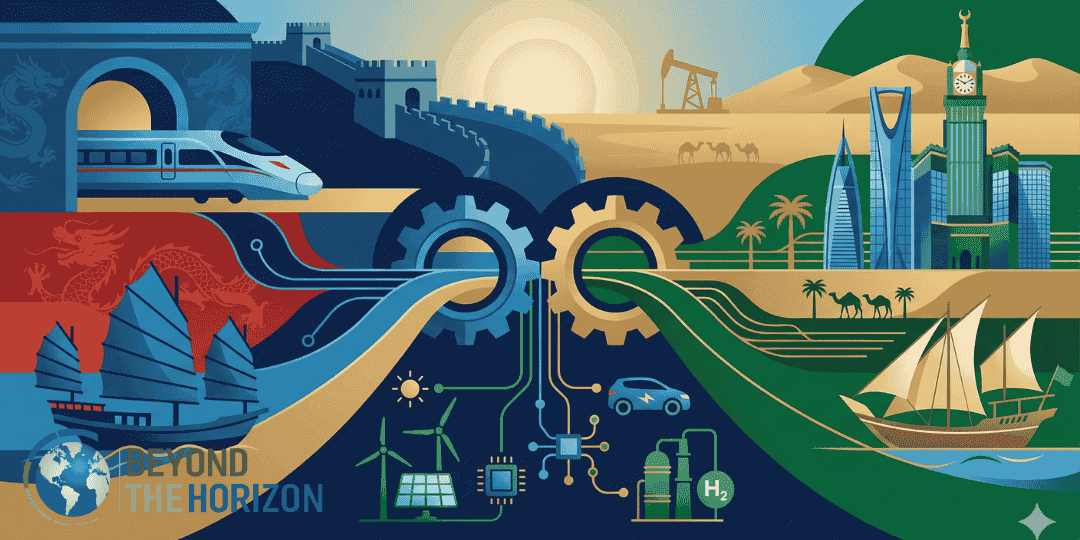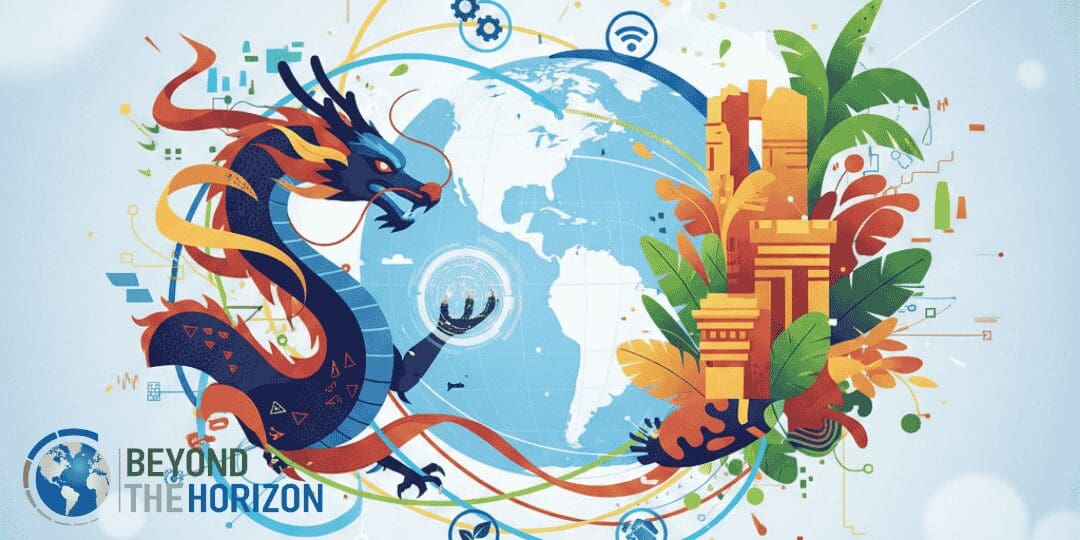Key Takeaways:
- Geopolitical Alignment: Xi Jinping’s May 2025 visit to Russia highlights deepening Sino-Russian cooperation amid heightened geopolitical tensions surrounding the Ukraine war. Xi’s prominent role in Moscow’s Victory Day commemorations reinforced mutual support against perceived Western dominance.
- Economic Integration: Russia and China continue to forge stronger economic ties, with bilateral trade reaching record highs ($245 billion in 2024). Chinese purchases of Russian energy and joint infrastructure projects, such as the proposed Power of Siberia 2 gas pipeline, underscore a strategic economic partnership crucial to mitigating Western sanctions.
- Historical Symbolism: The joint WWII commemorations by Xi and Putin carried potent historical symbolism, positioning their countries as guardians of an anti-fascist legacy. This narrative supports their current geopolitical stance and emphasizes a shared historical identity against Western narratives.
- Impact on U.S.-China-Russia Relations: Xi’s visit conveyed a clear message of unity, countering the Trump administration’s efforts to divide China and Russia. The trip underscored that both Moscow and Beijing view their relationship as essential in resisting U.S. diplomatic and economic pressures.
- Multipolar Strategic Vision: The Xi-Putin meeting reiterated a commitment to shaping a multipolar global order through collaboration in platforms such as the United Nations, SCO, and BRICS. Their alliance seeks to redefine international governance norms, prioritizing sovereignty and “true multilateralism” against perceived Western unilateralism.
Introduction: A United Front Amid War and Polarization
Chinese President Xi Jinping’s state visit to Moscow in May 2025 – timed with Russia’s grand World War II Victory Day celebrations – carried immense geopolitical weight. It came as Russia’s war in Ukraine ground through its third year, with global politics increasingly polarized between East and West. Xi’s presence in Moscow was a boost for Vladimir Putin, who has cast his Ukraine campaign as a fight against “modern-day Nazis”. Indeed, Putin thanked Xi for joining the 80th anniversary observances of victory over Nazi Germany and declared that China and Russia now stand together against “neo-Nazism”. This rhetoric tied the legacy of WWII to the current conflict: just as the Allies defeated fascism in 1945, Moscow portrays itself (and by extension Beijing) as defenders of the historical truth of that victory and opponents of any resurgence of fascism – a thinly veiled reference to Ukraine’s government. Ukraine and its Western allies reject Putin’s Nazi characterization as a “grotesque falsehood”, accusing Russia of an unprovoked imperial-style invasion. Xi’s highly publicized visit at this juncture signaled that Beijing is firmly in Moscow’s corner, even as the West isolates Russia.
The timing was critical. The celebrations in Moscow occurred “at a key moment in the war with Ukraine, as Moscow and Kyiv [came] under U.S. pressure to reach a peace deal”. In fact, reports indicated the United States – under President Donald Trump’s administration – was pushing Russia and Ukraine to negotiate an end to the conflict, even threatening to walk away from talks if progress stalled. For Putin, having Xi at his side in Moscow sent a message of strong Chinese backing, undermining any Western attempt to isolate Russia. Xi was “the most powerful of more than two dozen foreign leaders in attendance, outshining the others and emphasizing that China’s friendship is what matters most to Moscow. Tellingly, Ukraine’s government had urged countries to boycott Russia’s Victory Day parade, warning that foreign military participation would betray claims of neutrality. Most Western leaders indeed stayed away, leaving a spectacle dominated by Russia, China, and a handful of other allies. The optics of Xi and Putin together on the Kremlin stage underscored the emergence of a tighter Sino-Russian axis in defiance of Western pressure.
Both leaders framed their partnership as a force for stability in a divided world. In Moscow’s opulent Kremlin halls, they greeted each other as “dear friend” and cast themselves as guardians of global order and historical memory. Each is grappling with Washington’s assertive stance – Putin with U.S. involvement in Ukraine, and Xi with an ongoing trade war and strategic rivalry with the U.S. Under these conditions, the two have sought to present their countries as alternative centers of power championing a “more equal, multipolar world”. Xi explicitly inveighed against “unilateralism and bullying on the international stage,” a swipe at U.S. dominance, and vowed that China and Russia would shoulder their “special responsibilities” as major powers and U.N. Security Council members to uphold global stability. In effect, Moscow and Beijing are drawing closer together to withstand what they view as Western hegemony, each buttressing the other amid geopolitical storms – be it sanctions and diplomatic isolation in Russia’s case, or U.S. strategic pressure in China’s. The May 2025 meeting made clear that the war in Ukraine has accelerated this convergence, hardening an East-West divide reminiscent of a new Cold War.
Growing Economic Ties: Trade, Energy and Sanctions Relief
Beyond political theater, economic interdependence forms the bedrock of the China-Russia alignment. Xi’s visit spotlighted a burgeoning partnership in trade, energy, and infrastructure that has helped Russia withstand Western sanctions. Since the Ukraine invasion in 2022, Beijing has essentially given Moscow an economic lifeline. China is now Russia’s largest trading partner, and by 2024 their bilateral trade hit a record high of about $245 billion. Chinese purchases of Russian oil and gas have surged to make China the top buyer of Russian energy exports. This steady demand (often at discounted prices) provides critical revenue to Moscow while keeping China’s factories and vehicles running. As Putin himself noted, China buys more of Russia’s oil and gas than any other country – a crucial buffer as Europe cuts its energy dependence on Russia. In return, Russia has leaned heavily on Chinese imports for everything from machinery to consumer goods. With Western firms exiting the Russian market, Chinese brands in automobiles, electronics, and appliances have swiftly expanded their presence to fill the void. The result is a tighter economic embrace: Russia’s reliance on China for trade and technology has grown, and China has gained a secure source of commodities and a market for its goods, aligning both nations’ interests.
During the Moscow talks, Xi and Putin signed numerous agreements to deepen this “no limits” economic partnership. Energy infrastructure was high on the agenda. Notably, the two sides discussed the proposed “Power of Siberia 2” natural gas pipeline, a massive project to send Russian gas to China via Mongolia. This long-delayed pipeline had stalled over pricing disagreements, but economic pressures on both Beijing and Moscow have pushed them closer to compromise. For Russia, finding new gas markets in Asia is a priority after losing much of the European market; for China, additional gas supply boosts its energy security. Xi’s visit likely gave political impetus to such projects. Likewise, the leaders touted cooperation on transportation infrastructure across Eurasia – from railways to ports. Putin highlighted upgrades to the Trans-Siberian railway and development of the Arctic Northern Sea Route for shipping, which have steadily increased freight flows between Russia and. These routes, often discussed under China’s Belt and Road Initiative and Russia’s own infrastructure plans, promise to further integrate the two economies.
Crucially, sanctions mitigation underpins the economic relationship. Cut off from much of the Western financial system, Moscow has worked with Beijing to shift trade into rubles and yuan, bypassing the U.S. dollar. By the end of 2022, an estimated 63% of Russia’s imports from China were invoiced in yuan, a dramatic rise from prior years. This “yuan-ization” of trade helps Russia conduct commerce despite sanctions on its banks, while also internationalizing China’s currency. The two countries have also likely coordinated on sanctions evasion strategies – for example, using intermediary countries and complex shipping arrangements to keep Russian oil flowing to China and beyond. Xi’s delegation in 2025 included economic officials ready to sign an “extensive package” of deals, underscoring that the economic dimension of the partnership is broadening. It now spans not just energy, but also high-tech industries, finance, and infrastructure development. In short, China and Russia are knitting their economies together more tightly as a direct response to Western pressure. This provides mutual benefits: Russia can survive sanctions with China’s market and capital, and China gains a pliable economic partner rich in resources – all while jointly lessening their vulnerability to Western economic leverage.
Implications for U.S.-China-Russia Relations (The “Trump Factor”)
Xi’s meeting with Putin also needs to be understood in the context of U.S.-China-Russia triangular dynamics, particularly with a new U.S. administration under President Donald Trump in 2025. The Trump administration’s stance added an extra layer of complexity. Unlike his predecessor who treated Russia as a pariah, Trump came into office signaling a possible rapprochement with Moscow – a move that both intrigued and unnerved Beijing. Indeed, Washington was reportedly embarking on a behind-the-scenes diplomatic reset with the Kremlin, even as it publicly pressed Russia and Ukraine toward a peace agreement. Some observers noted that Beijing harbored concerns about a Russo-American thaw, fearing it could lead to a geopolitical realignment that leaves China isolated. Xi’s high-profile visit can be seen in part as insurance that Moscow stays closely aligned with Beijing, sending a reminder to Putin that China is his most reliable partner. The optics of warm Xi-Putin ties in Moscow likely counteracted any overtures from Trump, making clear that Russia gains more from sticking with China than risking a pivot West.
From Washington’s perspective, the deepening Xi-Putin entente is a strategic headache. The Trump administration has explicitly stated its desire to “pull apart” Russia and China – to prevent the emergence of a consolidated bloc adversarial to the U.S. Trump himself has long been unpredictable in his approach: he engaged in a trade war with China while at times praising Putin. Both Xi and Putin, as one analysis put it, have had to grapple with “the unpredictability of President Trump”, and this has in fact pushed Beijing and Moscow closer in presenting a united front. Each saw value in coordinating against what they view as a capricious U.S. approach. For example, as Trump put pressure on China economically, Xi’s incentive to secure Russian support grew; conversely, as Trump held out the possibility of rehabilitating ties with Moscow, Putin had reason to retain China’s trust as leverage. Thus, Trump’s policies inadvertently created both anxiety and opportunity in the Beijing-Moscow relationship.
During the May 2025 visit, these dynamics were evident. Xi and Putin emphasized their common vision for a multipolar world – implicitly rejecting American primacy – which doubles as a message to Washington that attempts to break their bond will not succeed. American officials had warned that Moscow and Beijing “need each other too much” to be split by outside pressure, and the outcomes of the Xi-Putin meeting seemed to bear that out. The two countries not only reaffirmed their “no limits” partnership from 2022 but also signed new agreements, indicating that U.S. efforts to drive a wedge were falling short. If anything, Trump’s mix of outreach to Russia and confrontation with China may have spurred China and Russia to double down on their alignment so neither could be caught alone. There is also the matter of Ukraine: Trump’s push for a quick peace (potentially on Russia’s terms) could relieve a burden on Moscow, allowing Putin to consolidate gains and refocus on great-power politics. Beijing’s stance on Ukraine has been officially neutral but sympathetic to Russia. In Moscow, Xi reiterated China’s call for a “fair and durable peace deal” in Ukraine – one that addresses all sides’ security concerns. This aligns well with a Trump-driven peace plan. But Xi’s larger signal was that China expects to be a stakeholder in any Eurasian security arrangement, not a sidelined player. In essence, Xi’s visit asserted that any U.S. move to reorder relations with Russia must reckon with China’s interests. The strong personal rapport displayed between Xi and Putin in May 2025 sent a clear message to Washington: the China-Russia partnership is resilient, and attempts by the U.S. to recalibrate the global balance by courting or pressuring one of them will face a united response.
A Multipolar Vision: Strategic Partnership on the World Stage
The Xi-Putin meeting in Moscow underscored broader strategic implications that extend well beyond bilateral ties. At its core, the deepening Sino-Russian partnership is about jointly championing a multipolar world order as an alternative to what they perceive as U.S.-led unipolarity. Both nations frequently stress “true multilateralism” and the primacy of international law via the United Nations, as opposed to alliances or blocs dictated by Washington. In their Kremlin talks, Xi and Putin cast themselves as defenders of the U.N.-centered international system. They agreed to “resolutely safeguard the U.N.’s authority” and uphold international justice, positioning their alliance as a counterweight to Western unilateral actions. Practically, this means Beijing and Moscow coordinate closely in multilateral forums. As permanent members of the U.N. Security Council, they have often voted in tandem – for instance, China has backed Russia (with vetoes or abstentions) on key resolutions regarding the Ukraine conflict, preventing Western attempts to isolate Russia diplomatically. This visit likely reinforced such coordination, with Xi and Putin jointly affirming that they would “stand together, resolutely safeguard the U.N.-centered international system…and continuously promote an equal and orderly multipolar world”.
Outside the U.N., the two powers are bolstering alternative international groupings. Platforms like the Shanghai Cooperation Organization (SCO) and BRICS are central to their vision. Xi and Putin have used these forums to build coalitions in the Global South and Eurasia that can act independently of Western institutions. In Moscow, Xi explicitly mentioned that China and Russia would “enhance coordination on multilateral platforms such as the United Nations, the SCO, and BRICS” to guide global governance reforms. Both countries portray themselves as champions of the developing world’s interests; they argued that together, they “defend the rights and interests of…the vast majority of developing countries” against hegemonic pressure. Through BRICS, Beijing and Moscow have advocated for reforms to the global financial system (such as reducing reliance on the U.S. dollar in trade and even discussing alternative reserve currencies). They have also supported BRICS expansion, bringing in other mid-tier powers, which dilutes Western dominance in international economic discourse. Through the SCO, a security and cooperation forum spanning Asia, they collaborate on counterterrorism, military exercises, and regional connectivity projects, extending their influence in Central and South Asia. During Xi’s visit, Putin noted Russia’s support for China’s current chairmanship of the SCO and looked forward to the SCO summit in Tianjin in September 2025. This signals that China-Russia solidarity within these organizations is at an all-time high.
Another strategic arena is the narrative of global governance. Xi and Putin consistently speak about building a “fair, democratic and multipolar world order”. To them, this involves pushing back against what they see as the West’s proclivity to impose its rules and sanctions on others. In their joint remarks, they vowed to oppose unilateral sanctions and “bloc confrontation”, code for Western alliances like NATO or AUKUS that exclude them. Instead, they propose an inclusive system where no single power can dictate terms – a vision that appeals to many countries in Asia, Africa, and Latin America. The Sino-Russian partnership provides a nucleus for this vision. By combining China’s economic heft and global reach with Russia’s military might and diplomatic clout, the two aim to reshape international norms on issues ranging from internet governance to sovereignty and non-interference. We see this in their joint emphasis that all global problems must be addressed with regard to “the interests of all countries” and in compliance with the U.N. Charter. Such statements, reiterated during Xi’s Moscow visit, telegraph a not-so-subtle critique of U.S. interventions and sanctions, while promoting their own principle of state sovereignty (often to shield themselves from external criticism on human rights or territorial issues).
Conclusion
In sum, Xi’s May 2025 trip to Russia solidified a partnership that is shaping up to be a defining factor in 21st-century geopolitics. Geopolitically, it signaled unwavering Chinese support for Russia amid the Ukraine war, accentuating a world increasingly split between U.S.-led and China/Russia-led camps. Economically, it showcased an ever-closer coupling of two major economies finding synergy in the face of sanctions and trade wars. Historically, it leveraged the powerful imagery of WWII alliance and victory to legitimize the modern-day alignment. Strategically, it delivered a message to Washington that Beijing and Moscow will not be pried apart – not by sanctions, not by diplomacy, and not by attempts to play one against the other. And on the global stage, it reinforced their joint mission to champion multipolarity and “true multilateralism” through institutions like the U.N., SCO, and BRICS.
As Xi and Putin stood together in Moscow in May 2025, they cemented what they have called a friendship with “no limits.” Each leader is navigating intense showdowns with the West – Russia in a hot war in Ukraine, China in a cold one with the U.S. over trade and influence – and each has found in the other a critical strategic partner. Their meeting amid booming cannon salutes and nostalgic war anthems was more than ceremonial; it telegraphed a shared resolve to remake the global order to better serve their regimes’ interests and ideals of security. This deepening Sino-Russian entente does not just react to world events; it is actively shaping them – from the outcome of the war in Ukraine, to the balance of power in Asia, to the norms that will govern the international system in years to come. The May 2025 summit in Moscow will be remembered as a milestone where geopolitical fault lines hardened, and the partnership of Xi and Putin stood firm, presenting a united front against the forces they jointly decry as threats to their vision of a just world order.
Related Infographics
